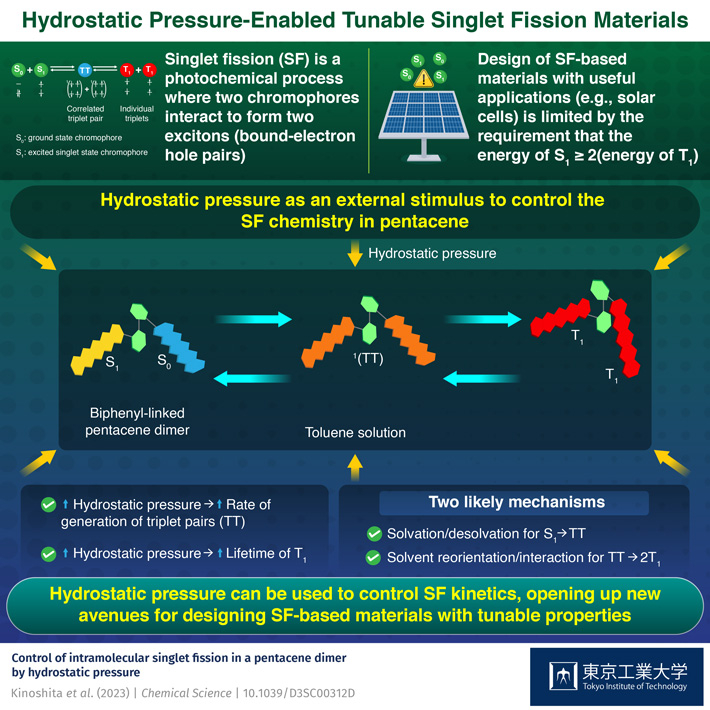Applying hydrostatic pressure as an external stimulus, Tokyo Tech and Keio University researchers demonstrate a new way to regulate singlet fission (SF), a process in which two electrons are generated from a single photon, in chromophores, opening doors to the design of SF-based materials with enhanced (photo)energy conversion. Their method overrides the strict requirements that limit the molecular design of such materials by realizing an alternative control strategy.

Singlet fission (SF) is a process in which an organic chromophore (a molecule that absorbs light) in an excited singlet state transfers energy to a neighboring chromophore, resulting in two correlated triplet exciton pairs (pairs of bound electron-hole states, a "hole" signifying the absence of an electron) that decay to low energy triplet excitons. These excitons have long lifetimes and show efficient light emission, making SF promising for efficient light energy conversion.
However, the molecular design of SF-based materials is limited by the requirement that the energy of the excited singlet state must be at least equal to the energy of the two triplet states. One way to overcome this limit is by applying external stimuli, such as temperature or pressure, to manipulate the SF process.
Now, in a collaborative study published in the journal Chemical Science, Prof. Gaku Fukuhara of Tokyo Institute of Technology (Tokyo Tech) and Prof. Taku Hasobe of Keio University in Japan demonstrate, for the first time, a hydrostatic pressure-based strategy for controlling the dynamics of the SF process, opening doors to the design and fabrication of novel, tunable SF-based materials.
"We demonstrated hydrostatic pressure-controlled formation and dissociation of correlated triplet pairs in SF by means of pressure-dependent UV/vis and fluorescence spectrometry along with fluorescence lifetime and nanosecond transient absorption measurements," explain Prof. Fukuhara and Prof. Hasobe.
In their study, the researchers used a biphenyl-bridged pentacene dimer as the model chromophore and tested its response for a range of hydrostatic pressures, from 0.1 MPa (atmospheric pressure) to 180 MPa, in three different solvents: toluene, methylcyclohexane and tetrahydrofuran.
Using a custom-built high pressure apparatus, the researchers measured the rate of exciton generation at different pressures by monitoring the fluorescence lifetime decay of the chromophore, which indicates how long the chromophore takes to emit a photon after the initial excitation. They found that the rate constant for the generation of correlated triplet exciton pairs increased with pressure, indicating that higher pressure leads to a faster SF process.
Using the technique of nanosecond transient absorption, the researchers then tracked the decay of the triplet excitons and found them to have shortened lifetimes under high pressure.
Based on quantum yield calculation and thermodynamic estimations, the researchers uncovered two mechanisms underlying the generating correlated pairs and individual excitons. In the case of the correlated exciton pairs, the SF process was driven by the solvation and desolvation of the molecule, leading to a more compact and thermodynamically stable exciton structure than the excited chromophore. In contrast, the individual excitons produced by the dissociation process were found to be thermodynamically bulkier, causing the solvent molecules to cluster around and deactivate them at high pressures.
With these findings, the researchers have shed light on the interactions between the different systems (pressure, solvent, chromophore, excitons) involved in the SF process, suggesting a suitable alternative to the conventional control strategy for SF.
"Our study provides a new perspective on the control of intramolecular SF using hydrostatic pressure as an external stimulus. This dynamic control concept could be extended to other SF scaffolds and relevant systems that are difficult to control in both ground and excited states," speculate Prof. Fukuhara and Prof. Hasobe.
We can certainly hope to see the application of SF-based materials in the design of efficient organic solar cells and photoconversion devices.
Reference
Authors : |
Tomokazu Kinoshita1, Shunta Nakamura2, Makoto Harada1, Taku Hasobe2 and Gaku Fukuhara1
|
Title : |
Control of intramolecular singlet fission in a pentacene dimer by hydrostatic pressure |
Journal : |
Chemical Science |
DOI : |
|
Affiliations : |
1 Department of Chemistry, Tokyo Institute of Technology
2 Department of Chemistry, Faculty of Science and Technology, Keio University |






